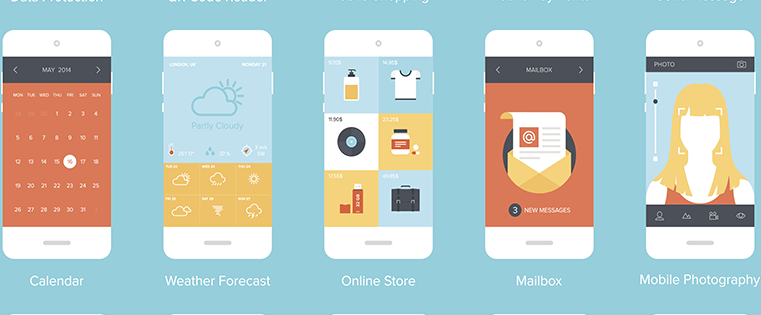1. In 2021, there were 7.1 billion mobile users. (Statista, 2021)
That’s 90% of the world’s population. It’s a staggering reminder of just how deeply mobile communication is engrained into our day-to-day. That number is predicted to reach 7.49 billion by 2025.
But, how many of those people are smartphone users? Around 6.5 billion, and this number is also expected to increase in the coming years. We also know that 85% of Americans own a smartphone, up from 35% in 2011.
2. At the end of 2021, mobile devices generated 54.4% of global website traffic. (Statista, 2022)
Global share of internet traffic by mobile devices, including both smartphones and tablets, leveled out around 50% in 2017 and has stayed that way into 2022. This is consistent with HubSpot’s own research, which sampled 400 web professionals and found that 41% of their website traffic comes from mobile. Desktops are no longer the only norm — website owners need to adopt a mobile mindset to capture this traffic successfully.
3. In 2021, Internet users spent half of their online time on mobile devices. (Statista, 2022)
If you’re using the internet, there’s about a 51% chance that you’re doing it on a phone or a tablet. This marks a five percent increase over just two years, showing that the average internet user is slowly taking a preference for their smartphone over a desktop.
4. 46% of Americans spend five to six hours on their phones per day. (Statista, 2021)
Plus, another 22% of Americans spend three to four hours a day on a phone. Essentially, this means that most of us are mobile experts (at that rate, it’s just four or five years to reach 10,000 hours). And, as experts, we expect incredible experiences. We compare our experiences on a new mobile app or website against every other one we’ve seen, including the high-performing ones we use every day. There’s very little room for error.
5. There are over one billion tablet users worldwide. (Statista, 2022)
“Mobile” and “smartphone” are often used interchangeably, but they’re not quite the same. Mobile devices include phones as well as tablets. There are over one billion estimated tablet users worldwide, including half of American — definitely not numbers to ignore.
When optimizing your site’s design for mobile, consider desktop and mobile layouts first and foremost, but don’t discount tablets either. A quality responsive site template should adapt well to large, small, and medium-sized screens alike.
6. 55.4% of internet users use mobile phones to buy online. (DataReportal, 2021)
As ecommerce continues to dominate, mobile ecommerce is growing right along with it. Visitors expect rich, responsive browsing and checkout experiences when they visit online stores. Additionally, 69.4% of internet users report using shopping apps on phones and/or tablets.
7. 50% of smartphone users are more likely to use a mobile site when browsing or shopping because they don’t want to download a mobile app. (Google/Ipsos, 2019)
Even though I’m referring to “mobile users” in a group, people within this group vary in how they prefer to browse. One area where opinions seem to be split is in the app vs. mobile site camps.
While many users don’t mind using a mobile app for their favorite brand, others prefer to save the time and make their purchase through a mobile site. It’s all the more reason to invest in a quality mobile site instead of or in addition to a mobile app.
8. 32% of small businesses already have a mobile app and 42% plan to build one. (Top Design Firms, 2021)
Even though roughly half of mobile users might prefer mobile websites, that still leaves the other half who have no problem downloading apps when they want them. That’s why nearly three quarters of small business either have an app or plan to make one in the future. If you find yourself buying from the same business repeatedly, the effort to download the app is outweighed by the convenience of having it on your home screen.
This doesn’t mean mobile apps are ideal for every small businesses, though. A business may lack the budget, headcount, or reason enough to build one, and that’s fine. A well-built mobile site can still get you far.
9. 73.1% of web designers think that non-responsive design is a top reason why visitors leave a website. (GoodFirms, 2021)
Ever land on a mobile site and find it clunky and hard to navigate? Maybe the buttons and text are too small and you need to pinch-zoom in to interact with anything. Or maybe the entire page looks like a cluttered mess. Either way, you probably wanted to leave.
There’s been a big push toward responsive design over the past 10 years, to the point where most of today’s web designers work it into their process from the start. “Mobile-first” design is now the industry standard for websites. That’s why this survey of over 200 web designers and freelancers ranked non-responsive design as one of the top reasons for exiting without conversion.
10. 53.8% of web designers cite “not being responsive on all devices” as a top reason for a website to be redesigned. (GoodFirms, 2021)
From the same survey of web designers, many believed that a lack of responsive design was reason enough to redesign a website. Other reasons given, including high bounce rates and low conversions, could also be solved by responsive design, as it reliably improves the all-around mobile user experience.
11. 3.7% of ecommerce website visits are converted to purchases on desktop, versus 3.3% on tablets and 2.2% on phones. (Statista, 2021)
The fact that conversion rate on smartphones is almost half of what it is on mobile could mean a couple of things. It could be a testament to how far behind mobile ecommerce websites are compared to desktop websites. It could also mean desktop users have a greater intent to purchase. My guess is that both of these factors come into play, so strive to pass that conversion benchmark on your own mobile site.
12. 59% of shoppers think being able to shop on mobile is important when deciding where to buy. (Google/Ipsos, 2019)
Whether its a mobile website or app, the majority of users at least want the option of purchasing on mobile. This makes sense — what if you wanted to make a purchase, but you’re out and about and don’t have your laptop with you? That urge to buy could be gone in minutes. Optimizing your mobile site may be extra work for your team, but it gives customers more freedom to buy where and when they want.
13. Nearly nine out of 10 smartphone users are not certain what brand to buy from before looking online. (Google/Ipsos, 2019)
Some users may already have a brand in mind when searching for a product, but rarely are they set on any specific option. Mobile shoppers are looking to be swayed, and it falls on your website to win them over. Delight mobile users with an engaging, high-performing mobile website. Leave no doubt in their mind they’ve landed in the right place.
14. 58% of smartphone users prefer companies whose mobile sites or apps remember them and their past behavior. (Google/Ipsos, 2019)
One reliable way to keep visitors happy? Make it easier for them when they come back to your site. You can recommend products based on their shopping habits, allow them to save site settings, and consider offering promotions and rewards for their return visits.
15. 64% of SEO marketers say mobile optimization is an effective investment. (HubSpot Blog Research, 2021)
The majority of SEO experts agree that companies should invest not just in their website design, but their mobile website design. Google factors in speed and mobile-friendliness into its rankings — we can expect fast, friendly, and familiar online experiences to rank higher in the SERPs than the competition.
HubSpot research has also found that 50.3% of marketers leverage mobile optimization in their SEO strategies, and 45.4% say that optimizing for mobile is one of the most effective strategies for ranking highly on the SERPs.
16. Mobile website shopping increased by 48% during the COVID-19 pandemic. (Statista, 2021)
Online mobile shopping was obviously popular pre-2020, but the global pandemic gave online spending a boost across all devices, including mobile. It’s also worth noting that mobile shopping on apps increased by 45% during the same period.
17. Reducing mobile site speed by 0.1 seconds results in an 8% increase in conversions. (Deloitte, 2020)
Speed matters. In an analysis of 37 retail, travel, luxury, and lead generation sites, Deloitte found that fractions of a second in load time have an astonishing effect on conversions. Perhaps its most important finding was that a 0.1 second drop in mobile load time correlated with an 8.4% increase in conversions among retail customers. If that’s not a case for keeping your mobile website fast, I’m not sure what is.
18. Reducing mobile site speed by 0.1 seconds results in a bounce rate improvement of 8%. (Deloitte, 2020)
Deloitte also discovered that small improvements in mobile performance also help lower bounce rates. That’s expected to an extent — the longer the load time, the more likely users are to leave the page without interacting with it. However, one-tenth of a second was all it took to hold some users on the page. Imagine if you improved things by one whole second, or several seconds. Seem worth it?
19. About 15 billion mobile devices had 5G connections in 2021. (Statista, 2021)
Mobile users worldwide have been adopting 5G since it became available in 2019, providing a significant speed upgrade to 4G. This number is expected to reach around 20% of the world’s population by 2025.
What does this mean for optimizing your site then? While the spread of 5G is definitely a good thing, you can’t assume that most mobile devices are operating on the fastest connection available. When planning, building, and testing your mobile site or app, know that a large portion of your mobile users will be accessing your site over a less-than-optimal connection.
Time to Optimize
Have you ever heard of a brick-and-mortar business that turned away half of its visitors at the door? Other than super fancy restaurants, maybe?
For that reason alone, make mobile optimization a priority on your list of website to-dos. And if that’s not enough, you now know a better mobile experience means fewer bounces, more engagement, more conversions, and more revenue, period. It’s time to adapt.
Mobile Optimization





![10 Best Mobile Friendliness Tests [+ What Does it Mean to be Mobile Friendly?]](https://53.fs1.hubspotusercontent-na1.net/hubfs/53/mobile-friendliness-test.jpg)






